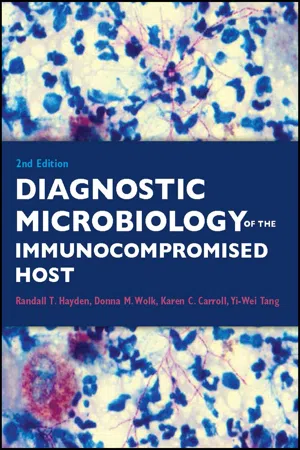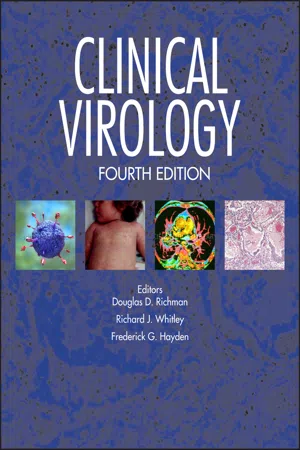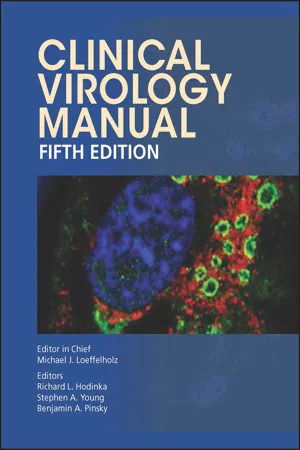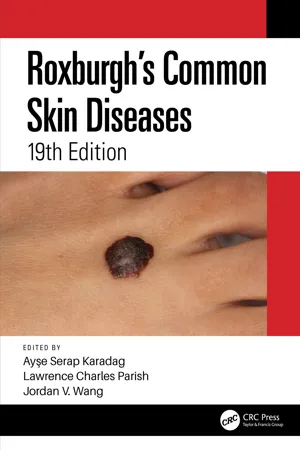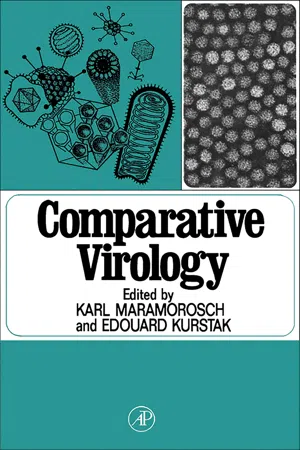Biological Sciences
Herpes Simplex Virus
Herpes simplex virus (HSV) is a common virus that causes cold sores and genital herpes. There are two types of HSV: HSV-1, which typically causes oral herpes, and HSV-2, which usually causes genital herpes. The virus is highly contagious and can be transmitted through direct contact with an infected person or their bodily fluids.
Written by Perlego with AI-assistance
Related key terms
9 Key excerpts on "Herpes Simplex Virus"
- eBook - ePub
- Randall T. Hayden, Karen C. Carroll, Yi-Wei Tang, Donna M. Wolk, Randall T. Hayden, Karen C. Carroll, Yi-Wei Tang, Donna M. Wolk, Randall T. Hayden, Karen C. Carroll, Yi-Wei Tang, Donna M. Wolk(Authors)
- 2016(Publication Date)
- ASM Press(Publisher)
1Adriana Weinberg2D. Scott Schmid36 Herpes Simplex Virus and Varicella-Zoster Virus
Herpes Simplex Virus
Description and Pathophysiology of Infection
Herpes Simplex Viruses (HSV) are enveloped large DNA viruses (approximately 152,250 to 154,750 base pairs, depending on HSV type, and 90 transcriptional units). HSVs are α-herpesviruses (family Herpesviridae) and are divided into three major clades. There are two HSV types (HSV 1 and 2) that are genetically distinct but that are colinear and share roughly 83% genomic homology (1 ). HSV from mucocutaneous lesions, or from asymptomatic shedding in the oral or genital secretions from an infected contact, enters the skin/mucosa of a new host through minor breaks or abrasions to infect the underlying epithelium. Infection at the dermal–epidermal junction produces characteristic skin lesions. These begin as macules and papules that culminate in vesicles that contain infectious virus (Fig. 1A ). These form pustules that rupture after 2 days; the resulting ulcers and crusts form within 96 hours. Vesicles and pustules are most likely to contain infectious virus, whereas ulcers and crusts reliably contain HSV DNA. Local vesicle formation is the hallmark of HSV infection, but vesicles may not be appreciated on mucosal surfaces because they rupture shortly after forming (Fig. 1B ). An essential characteristic of α-herpesviruses during primary infection is entry into a permanent latent relationship with sensory neurons, with the potential for subsequent reactivation to cause recurrent local infections (2 ).Figure 1 (A) First-episode HSV in an HIV-infected patient. (B) Genital HSV in a renal transplant recipient. (C) Typical recurrent HSV. (D) Atypical chronic recurrent HSV in a bone marrow transplant recipient.The first infection with either type of HSV is considered a primary infection. A subsequent infection with the other HSV type is termed a nonprimary first-episode (or initial ) infection with that new type (3 ). The clinical course of first-episode infections lasts 10 to 17 days, with fever, malaise, and headache sometimes present in the early phase. Nonprimary infections may be milder or truncated (4 ). HSV from the base of either primary or nonprimary first-episode lesions ascends in the sensory nerves that innervate the infected skin/mucosa to reach sensory ganglia, where it infects neurons and remains latent for life. In the first year after first-episode infection, approximately one-third of days are associated with reactivation of HSV in neurons (5 ). This HSV can travel retrograde in the sensory nerves to the area of skin/mucosa that was initially infected, and it either causes asymptomatic shedding (if at a mucosal surface) or may propagate in the skin/mucosa to cause new skin lesions similar to the initial infection, which is termed recurrent genital herpes or recurrent oral herpes infection (“cold sores; fever blisters”). Approximately 65% of reactivations are asymptomatic (6 ). Reactivation frequency declines with increasing interval after the first-episode infection. The outcome of reactivated latent HSV may be determined by the HSV-specific T-cell responses in the vicinity of the termini of axons where the reactivated HSV emerges (7 ). The clinical course of recurrent HSV is shorter than primary infection, lasting less than one week, and consists of fewer, smaller, and less painful lesions than the initial infection (4 ) (Fig. 1C - eBook - ePub
- Douglas D. Richman, Richard J. Whitley, Frederick G. Hayden, Douglas D. Richman, Richard J. Whitley, Frederick G. Hayden, Douglas D. Richman, Richard J. Whitley, Frederick G. Hayden(Authors)
- 2016(Publication Date)
- ASM Press(Publisher)
9 ). Notwithstanding these limitations, HSV is one of the most successful human pathogens. In most societies, its penetration is 100% of the population, and it persists in a human for life. Numerous studies carried out in recent years suggest that it accomplishes its mission by tightly regulating its growth and resultant morbidity.VIROLOGY
Classification
Herpes Simplex Viruses belong to the family Herpesviridae (10 ). The >100 known members of this family share the structure of their virions, general features of their reproductive cycle, and the capacity to remain latent. They differ, however, in many respects, and have been classified into three subfamilies (alpha, beta, gamma) with respect to the details of their replication, the cells in which they remain latent, gene content, and gene organization. HSV types 1 and 2 belong to the subfamily Alphaherpesviridae (11 ).Virion Structure
The HSV virion consists of four concentric components. From the center out, these are: (1) an electron-dense core containing viral DNA and polyamines, (2) an icosadeltahedral capsid consisting of capsomeres (12 ), (3) an amorphous layer of proteins, designated tegument, surrounding the capsid, and (4) an envelope containing lipids and studded with at least 10 viral glycoproteins and several nonglycosylated membrane proteins.Herpes Simplex Viruses have genomes that consist of a single double-stranded DNA molecule (12 , 13 ), which is in excess of 152 kbp (the exact size depends on the number of terminal repeats). The G+C content of HSV-1 DNA is 68% and 69% for HSV-2 DNA. The HSV-1 and HSV-2 genomes encode at least 84 different polypeptides (12 , 14 ). The DNAs consist of two covalently linked components, Large and Small (L and S), each consisting of stretches of unique sequences designated UL and US that are flanked by the inverted repeats ab and ca, respectively. The two components invert relative to each other to yield four populations of molecules differing solely in the relative orientation of US and UL (15 ). Although they differ with respect to nucleotide sequence and restriction endonuclease cleavage sites, and in apparent sizes of many viral proteins they encode, the HSV-1 and HSV-2 genomes are collinear and readily form intertypic recombinants in the laboratory (15 - eBook - ePub
- Richard L. Hodinka, Stephen A. Young, Benjamin A. Pinksy, Richard L. Hodinka, Stephen A. Young, Benjamin A. Pinksy(Authors)
- 2016(Publication Date)
- ASM Press(Publisher)
26 Herpes Simplex Viruses and Varicella Zoster Virus SCOTT H. JAMES AND MARK N. PRICHARDVIRAL CLASSIFICATION AND BIOLOGY
The herpesviruses are classified in the family Herpesviridae based on the characteristic large linear double-stranded DNA genome packaged within an enveloped icosahedral capsid. Members of this family have been identified in almost all animal species, and the specific herpesviruses are usually restricted to a single species. Nine human herpesviruses have been described: HSV-1, HSV-2, varicella zoster virus (VZV), Epstein-Barr virus (EBV), human cytomegalovirus (CMV), human herpesvirus 6A (HHV-6A), human herpesvirus 6B (HHV-6B), human herpesvirus 7 (HHV-7), and human herpesvirus 8 (HHV-8). All these viruses are structurally similar and encode a large number of biosynthetic enzymes involved in the synthesis of viral DNA as well as structure proteins that compose the capsid and tegument, as well as envelope glycoproteins that are required for infection.These similarities, however, belie the biological diversity among the human herpesviruses, and they are further classified into three subfamilies. The Alphaherpesvirinae includes HSV-1, HSV-2, and VZV, all of which exhibit a relatively short replication cycle in primary human fibroblast cells and the ability to establish latent infections in sensory ganglia. Betaherpesvirinae replicate more slowly and establish latency in secretory glands and myeloid precursor cells and include CMV, HHV-6A, HHV-6B, and HHV-7. The Gammaherpesvirinae , EBV and HHV-8, generally replicate in lymphoblastoid cells and establish latent infections in lymphoid tissue. One common theme among all the herpesviruses is the establishment of lifelong infections that remain largely quiescent, yet become problematic in immunocompromised hosts. In this chapter, we will consider the Alphaherpesvirinae - eBook - ePub
- Stacey B. Day, Robert A. Good(Authors)
- 2014(Publication Date)
- Academic Press(Publisher)
(Fig. 1) .Fig. 1 Evolution of species with Herpesviruses Number in brackets = number of herpesviruses identified in each species.Species underlined = species susceptible to herpesviruses from other species.* = species with herpesviruses which have been found to infect other species under natural conditions.Herpesviruses are characterized as particles measuring around 100 nanometers in diameter, having an icosahedral structure with 162 subunits or capsomeres and surrounded by an envelope which is derived from host cell membranes; the enveloped particles measure approximately 180 nanometers in diameter. Herpesviruses contain double-stranded DNA, develop within the nucleus and form intranuclear inclusions and, in some cases, intracytoplasmic inclusions in infected cells (2) .The pathogenetic, immunological and clinical features of herpetic infections, including their not uncommon association with cancer in man and other vertebrates, are presented in this report from two viewpoints. First, a comparative perspective will be used to indicate the remarkable pathobiological unity which exists among this large group of viruses. We will then focus on the host cell membrane alterations induced by herpesviruses, using Herpes Simplex Virus as an example, since such membrane changes appear to be intimately related to mechanisms associated with cell transformation and immunological responses. - eBook - ePub
- Ayşe Serap Karadag, Lawrence Charles Parish, Jordan V. Wang, Ayse Serap Karadag, Lawrence Charles Parish, Jordan Wang(Authors)
- 2022(Publication Date)
- CRC Press(Publisher)
7Viral InfectionsSoo Jung Kim and Annie DaiDOI: 10.1201/9781003105268-7CONTENTS
Herpes Simplex Herpes Zoster Verrucae Molluscum Contagiosum Varicella (Chicken Pox) Hand-Foot-Mouth Disease Erythema Infectiosum COVID-19 Final Thought Additional ReadingsDefinition: Viral infections encompass a wide variety of conditions. Such dermatologic manifestations can be caused by either the direct infection of the skin or the body’s reaction to a viral infection. It is important to recognize the clinical characteristics and appropriate treatments.HERPES SIMPLEX
Synonyms: Herpes, cold sore, fever blister, sun soreOverview: Herpes simplex is a DNA viral infection by the Herpes simplex virus (HSV) resulting in mucocutaneous lesions. Infections can be caused by type 1 (HSV-1) and type 2 (HSV-2). HSV-1 is the main cause of orolabial herpes and is more prevalent than HSV-2, the main cause of genital herpes.Clinical presentation: The initial primary infection of HSV-1 is spread through direct contact with contaminated body fluids. This may be asymptomatic or with prodromal symptoms and signs, such as malaise, lymphadenopathy, and fever, followed by mucocutaneous lesions, which resolves without sequelae in 1–2 weeks. The recurrent infections can occur due to latent virus in sensory ganglia neurons (Figure 7.1 ). These are often triggered by stress and sunlight, being preceded by localized pain, burning, and tenderness. The common locations are near or on the lip and present as characteristic painful, uniform grouped vesicles on an erythematous base (Figure 7.2 ). These will progress into grouped pustules and crusted ulcers that will heal spontaneously.Herpes labialis.Figure7.1HSV lesions of grouped vesicles on an erythematous base.Figure7.2Source: - eBook - ePub
- Karl Maramorosch, Edouard Kurstak(Authors)
- 2014(Publication Date)
- Academic Press(Publisher)
Grüter, 1924 ). Nevertheless, despite the suspicion that nearly every species in the animal kingdom harbors at least one and possibly more herpesviruses, the family Herpesviridae is not blessed with many known members. There are several reasons for this: herpesviruses are complex viruses, cantankerous, and at times difficult to grow. Recent findings of herpesviruses associated with certain cancers of man and animals should greatly spur the discovery of new members of this group.The objective of this paper is to delineate briefly the available information concerning the structure and morphogenesis of the herpesvirus virion.FIG. 1 Herpes simplex nucleocapsids and virions negatively stained with silicotungstic acid. (A) Nucleocapsids (1) and intact virion (2) which is impervious to negative stain. (B) and (C) Enveloped nucleocapsids into which the stain has permeated revealing some details of the structure of the envelope.II Chemical Composition of the Herpesvirion
A PURIFICATION
Chemical analyses of viruses require preparations of reasonable purity with respect to the specific component being analyzed. Preparations of virus relatively free from contamination with host DNA have been reported. The procedure for purification with respect to host DNA is based on the observation that enveloped virions migrate into the cytoplasm which is free of host DNA as long as the nuclei remain intact. Provided the cytoplasm is extracted with care to prevent nuclear breakage and then treated with DNAse to digest DNA adhering to the surface of the virions (Smith, 1963 - eBook - ePub
Infections of the Central Nervous System
Pathology and Genetics
- Fabrice Chretien, Kum Thong Wong, Leroy R. Sharer, Katy Keohane, Francoise Gray, Fabrice Chretien, Kum Thong Wong, Leroy R. Sharer(Authors)
- 2020(Publication Date)
- Wiley-Blackwell(Publisher)
The α‐herpesviridae are characterized by an extremely short reproductive cycle, rapid destruction of the host cell, and the ability to replicate in a wide variety of host tissues. They characteristically establish latent infection in sensory nerve ganglia. They include:- HSV‐1: Herpes Simplex Virus 1/human herpesvirus 1
- HSV‐2: Herpes Simplex Virus 2/human herpesvirus 2
- VZV: varicella‐zoster virus/human herpesvirus 3
- CMV: cytomegalovirus/human herpes virus 5
- HHV‐6: human herpesvirus 6
- HHV‐7: human herpesvirus 7
- EBV: Epstein‐Barr virus/human herpesvirus 4
- HHV‐8: human herpesvirus 8
HHV‐8 is the causative agent of Kaposi sarcoma. In Zambian individuals positive for human immunodeficiency virus (HIV ) with Kaposi sarcoma, infection by HHV‐8 has been demonstrated in CNS resident cells, primarily neurons [2 ]. Rare clinical observations of encephalitis, encephalomyeloradiculitis, or meningomyelitis associated with HHV‐7 infection have been reported [3 ]. A possible association between HHV‐6 and multiple sclerosis has been suggested [4 ]. However, only five herpes viruses have consistently caused pathologically proven CNS infectious damage: HSV‐1, HSV‐2, VZV, CMV, and EBV.This chapter will describe infections of the CNS in HSV‐1 and HSV‐2. VZV and EBV infections are described in Chapter 6 and CMV infection in Chapter 7 .Definition of the disorder, major synonyms, and historical perspective
HSV‐1 and HSV‐2 produce two major disease patterns: (i) primary and recurrent HSV infections in adults and children, which may be asymptomatic, cause mucocutaneous lesions, or more rarely, keratitis or CNS infections; and (ii) primary neonatal infection acquired perinatally.Colloquial terms for orolabial herpes infections are “cold sores” or “fever blisters.” “Herpetic whitlow” refers to vesicular lesions on the thumb or fingers.Greeks coined the word “herpes,” meaning “to creep or crawl” along the skin. Hippocrates used this term to describe skin lesions, some of which were likely herpetic infections [5 ]. In the 1920s, the Mathewson commission was one of the earliest reports to suggest HSV caused encephalitis in humans [6 ]. Goodpasture and others demonstrated that material from herpetic lip and genital lesions produced encephalitis when introduced into the scarified cornea or skin of rabbits [7 ]. The first pediatric case report of Herpes Simplex Virus encephalitis (HSVE) was published in 1941 [8 ] and the first adult case in 1944 [9 - Richard L. Guerrant, David H. Walker, Peter F. Weller(Authors)
- 2011(Publication Date)
- Saunders(Publisher)
in vitro . Infection may be widespread while latency is likely established in secretory epithelial tissues and leukocytes. The gammaherpesviruses – EBV and HHV-8 – infect lymphocytes, epithelial tissues, and mesenchymal cells, while latency is likely established in B lymphocytes. The gammaherpesviruses are distinct from the other herpesvirus subfamilies in being causally linked to malignant lymphoid, epithelial, and mesenchymal tumors in humans.The herpesviruses are susceptible to nucleoside analogs such as vidarabine, trifluridine, penciclovir, acyclovir, ganciclovir, famciclovir, and valacyclovir, as well as the viral DNA polymerase inhibitors foscarnet and cidofovir.6, 7 Antiviral drug resistance to both nucleoside analogs and DNA polymerase inhibitors is of concern particularly in the immunocompromised patient.8 A live, attenuated VZV vaccine (Varivax) is effective in preventing primary varicella (chickenpox) infection, while a higher dose of the same vaccine (Zostavax) is effective in preventing herpes zoster and postherpetic neuralgia. Subunit vaccines against HSV, CMV, and EBV are under development.Herpes Simplex Viruses
The Agent
The infectious nature of HSV was first demonstrated by induction of typical dendritic corneal lesions in rabbits from material obtained from human herpes keratitis and herpes labialis lesions.9 The distinction between the two virus strains, HSV-1 (above-the-belt lesions) and HSV-2 (below-the-belt lesions), was first made in 1968,10 although it is now recognized that either virus strain can cause comparable primary infection at any anatomic site.11 HSV virions contain 150 kbp of linear, double-stranded DNA encoding at least 84 proteins.12 HSV gene expression may be temporally classified into three distinct phases termed alpha (immediate early), beta (early), and gamma (late). Alpha genes are expressed without prior protein synthesis and are largely involved in transcriptional transactivation. Beta genes are dependent upon prior alpha gene expression and encode proteins required for DNA replication. Gamma genes are dependent upon prior DNA replication and encode virion structural proteins. Beta and gamma gene expression is accompanied by inhibition of cellular DNA, RNA, and protein synthesis and by cell death.13 At least 12 glycoproteins are embedded in the viral envelope; some of these glycoproteins are important in viral infectivity and also as targets of the immune system.14 The antigenic difference between glycoprotein G (gG) from HSV-1 (gG-1) and HSV-2 (gG-2) is the basis for serologic distinction of the two HSV types.15 In culture, HSV inhibits host cell macromolecular synthesis and causes rapid cell lysis of a number of cell types.16, 17- eBook - ePub
- T. Natasha Posner(Author)
- 2008(Publication Date)
- Routledge(Publisher)
Even the quality of the herpes virus which has proved problematic in the development of a vaccine to prevent infection – its ability to lie dormant in nerve cells – may be put to a good use in a development by a team of British virologists at University College London Medical School, which may result in a more effective and longer-lasting treatment for Parkinson’s disease. The idea is that if the virus could be engineered to make dopamine it could act as a vector, carrying the genetic recipe for dopamine into the brain cells. The team is attempting to develop a safe way of doing this by specific modifications of the herpes virus.HSV, PSYCHONEUROIMMUNOLOGY AND THE BODY
The majority of human bodies harbour the Herpes Simplex Virus without people knowing it or being troubled by it. Recurrence of symptoms of this viral infection is a prototypical stress-associated condition. It takes advantage of its human host’s vulnerability when the physiological system is under stress, whether that stress is because of illness, lack of sufficient rest or sleep, as a result of psychological distress, or some other factor. While most of the time the immune systems of the majority of the population infected with the virus prevent it from expressing itself symptomatically, a minority are regularly or intermittently troubled. The combination and balance of factors which keep the expression of the virus repressed in one person and not another is still a mystery. Various possible mediating factors such as self-esteem, cognitive coping mechanisms, locus of control and social support have been implicated in the association between biopsychosocial factors and HSV symptom recurrences. There is extensive evidence that lack of social support, life stress and depression are associated with one another, but the mechanism of their association is controversial (Vilhjalmsson 1993). Similarly, there is much evidence that social support and health are positively associated, but no significant correlations have so far been demonstrated between the measure of psychological or social support and objective
Index pages curate the most relevant extracts from our library of academic textbooks. They’ve been created using an in-house natural language model (NLM), each adding context and meaning to key research topics.
